I experienced one of those profound aha moments when I came across this quote by Australian architect Glenn Murcutt: “I see simplicity not so much as a disregard for complexity, but as a clarification of the significant.” In this time of internet meetings, constant cell phone upgrades and overbooked airline flights, simplicity seems more attractive and significant than ever before.
Change is perhaps best begun where we live. For many, this change could start in their gardens, their most private personal spaces. Intrigued? Let’s look at how simplicity can feed your soul and ultimately change your world.
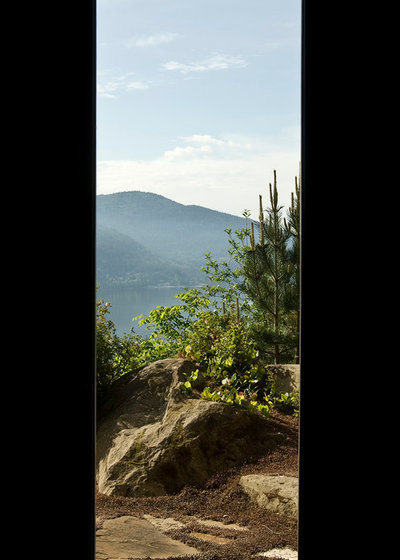
Private Gardens Design
Connect to your surroundings. It is true that no one is an island; we are connected to a larger part. Why not explore and connect to your greater environment? Consider inviting the outside in, but on your own terms. You will feel empowered by doing so.
I am a big fan of garden windows and gates because they link us to the outside world while protecting our vulnerabilities and personal space. I particularly enjoy windows cut in hedges. They frame our world and, in doing so, increase our understanding and appreciation of it.
If you live in a picturesque area, as is shown here, and privacy is not an issue, create a large opening to invite the outside in. If you live in an urban environment, create a link to the outside that gives you a glimpse of it while maintaining your privacy and control. Perhaps a gate incorporating a speakeasy door, a wall containing a stained glass insert, or a perforated metal panel would be appropriate.
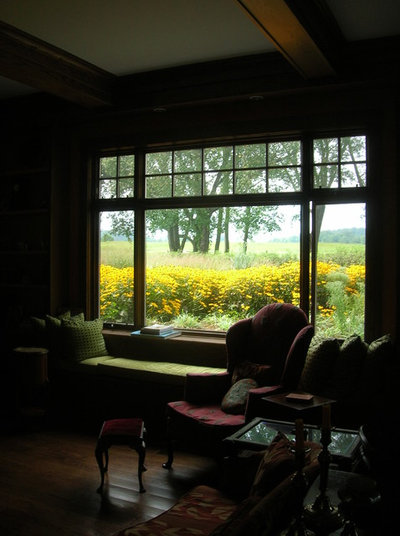
jonathan alderson landscape architects, inc.
If your personal space adjoins a large woodland or grassland, don’t fight it; embrace it. Begin to think of your garden as a transition point between you and nature. The simplicity of such spaces is profound and significant.
The garden portrayed here uses a mass planting of black-eyed Susans
(
Rudbeckia hirta, zones 4 to 9) to make the transition from garden to grassland. Planting en masse embodies simplicity because it reads as one large element instead of a plethora of individual plants. Notice how the flowers capture attention yet move the eye toward what lies beyond. An English cottage garden would be inappropriate and uncomfortably busy in a setting such as this.
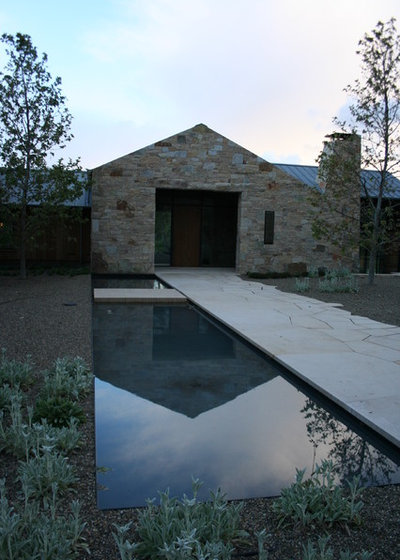
Frank & Grossman Landscape Contractors, Inc.
Embrace your home’s architecture. There is something profoundly significant about a well-authored relationship between a home and the land upon which it sits. In the space shown here, simplicity of lines and the home’s reflection in the water create a perfect homogeneous relationship between home and land.
You may be asking, “What do I do about my nondescript tract home sitting in the suburbs?” A simple first step would be to look at your home’s architectural style. Craftsman homes, for example, blend perfectly with gardens featuring mass plantings of ornamental switchgrass (
Panicum spp and cvs, zones 4 to 9), Russian sage
(
Perovskia cvs, zones 4 to 9), and ornamental
sage (
Salvia nemorosa cvs, zones 5 to 9). Several specimen trees such as Japanese maples (
Acer palmatum, zones 5 to 8), contorted filbert
(
Corylus avellana ‘Contorta’, zones 4 to 8) and structural conifers round out the garden.
If your home has no clearly defined architectural style, take note of its exterior color and cladding. If your home is clad with gray cultured stone with rose highlights, for example, use that as a starting point for choosing an appropriate plant palette. You may consider plants with silver or blue foliage as well as those with blue, purple and pink flowers. An oversize Italian terra-cotta pot could be an appropriate focal point. Be sure to include some dark green shrubs to give the eye a place to rest.
I recently designed a garden for a nice but nondescript home with regard to architectural style. What drew my eye was the way the facade stepped back several times with the front door on the farthest, most recessed portion. I enjoyed the four stepped-back corners so much that I highlighted each one with a tree-form Diablo ninebark (
Physocarpus opulifolius ‘Monlo’
, zones 2 to 8), thus creating rhythm while embracing the architecture. Additionally, I created a sense of journey by planting en masse
blue dune lyme grass (
Elymus arenarius ‘Blue Dune’, zones 4 to 9), which coincidentally repeated the color of the home’s tinted windows. The result is clean and simple.
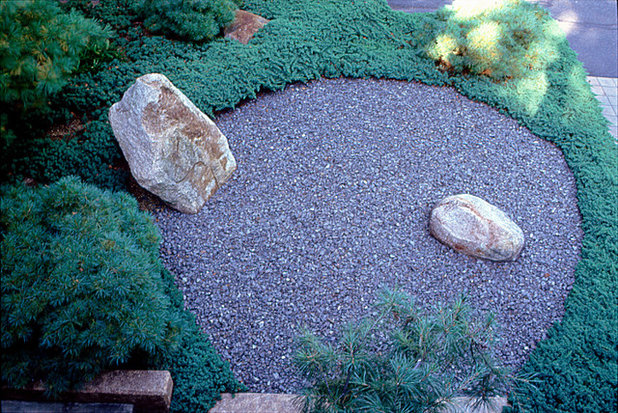
Julie Moir Messervy Design Studio (JMMDS)
Explore a philosophy. If you subscribe to the idea, as I do, that a garden should be an extension of its owner, begin to look for ways to interject your personality and life philosophy into your space. By doing this, you enable your garden to tell a story rather than just decorate a yard. In my mind, this is one of the highest forms of gardening.
Perhaps you are a peaceful person who is frequently engaged in deep thought. You are tactile by nature. If so, you will most likely find the garden shown here to be very satisfying. The simplicity of shapes, the monochromatic planting scheme and the crunch of gravel underfoot will be a positive experience for you.
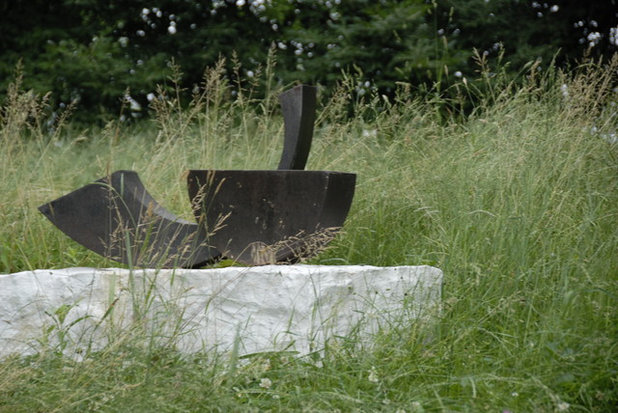
jonathan alderson landscape architects, inc.
Properly place your art. Simple art is frequently shown to best advantage in simple surroundings. This steel sculptural piece is a perfect choice for this grassland area.
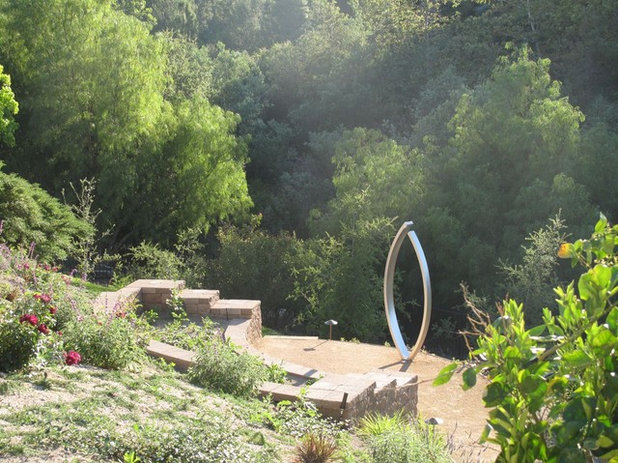
TerraSculpture
Notice how well this sculptural piece is sited as a focal point. The proportion and scale of the art allow it to stand on its own merit in its surroundings. Additionally, the lines of the piece pull the eye upward to appreciate the towering trees. Here, simplicity makes its statement.
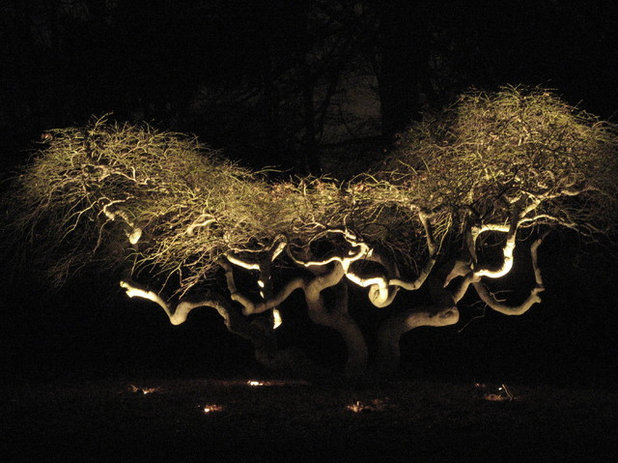
Possidento Lightscapes LLC
Don’t overlook the opportunity to view a specimen tree as a living sculpture. This spectacular
maple resembles storm clouds rolling in over the horizon. Properly lit at night, it commands the attention it deserves.
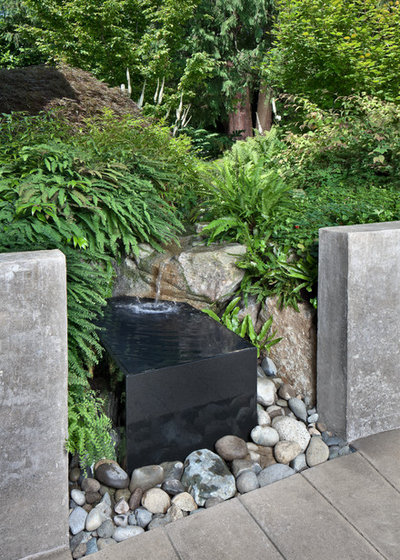
Broadhurst + Associates
Include contrast. If your garden is anything like mine, there’s always room for one more plant, or three. How to make sense of the space and introduce a cohesive yet simple overall design is always a challenge. Enter juxtaposition. By creating contrast between this exuberantly full space and a simply designed focal point, the designer was able to create a profound garden. The modern understated sculptural fountain gives the space a unique identity. After all, we expected a naturalistic waterfall, didn’t we?
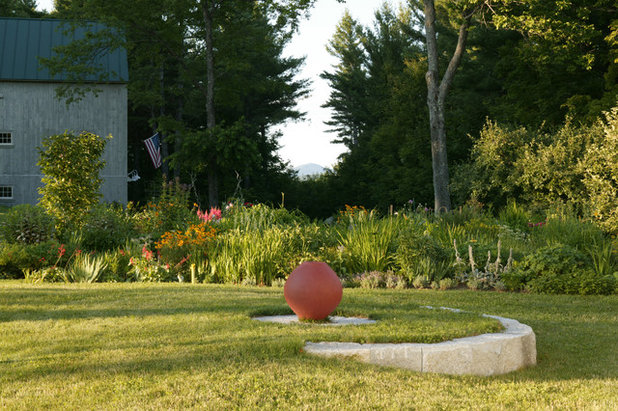
Julie Moir Messervy Design Studio (JMMDS)
Embrace what’s yours. There is an innate part of human nature that wants to claim and protect what is yours. Walls are erected to prove it; wars are fought to defend it.
While lawns have been receiving bad press as of late, there are occasions when turf is necessary. I generally begin by asking new clients whether they have a lawn by design or by default. The lawn shown here, highlighted by a sculptural sphere, reminds me of that unwritten childhood law: The one who holds the ball is the one who owns the game. This sphere boldly takes possession of the lawn, and why not? If you have a purposeful lawn by design, own it.
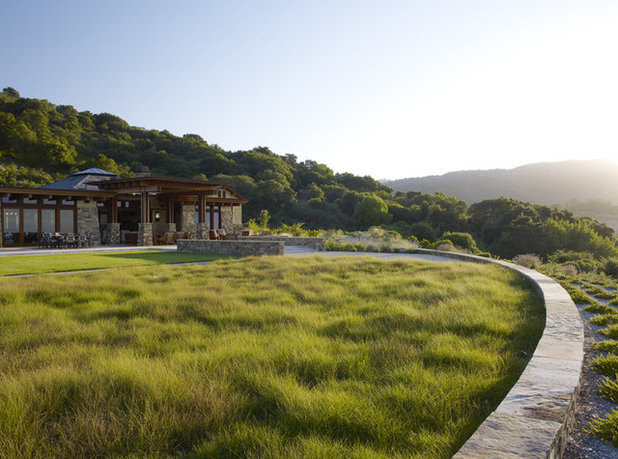
Christopher Yates Landscape Architecture
This lawn, one created with native grasses, stands in contrast to the previous one, but the elements are quite similar. The low stone retaining wall forms an apron that both claims the area and connects to the home. This profound yet simple space is functional; it is both separate from the surrounding environment and connected to it.
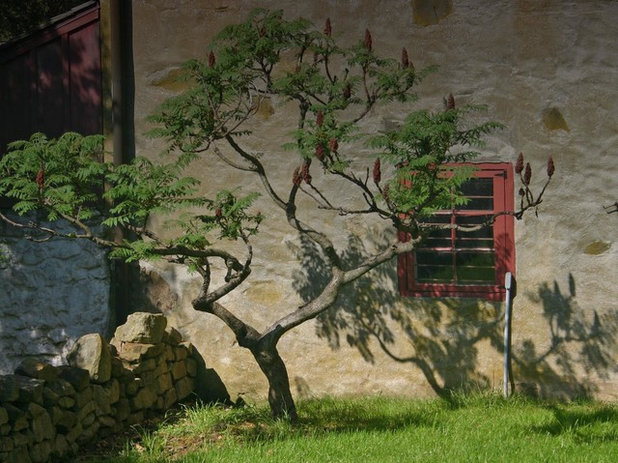
jonathan alderson landscape architects, inc.
Create a snapshot. Small vignettes can capture fleeting moments as well as any camera. This simple trinity of stone, tree and lawn is profound. The great thing about vignettes such as this is that they can be created in most any garden, from the small urban courtyard to the sprawling estate. It’s all about noticing the ever-changing relationships between the natural and the manufactured and creating beauty from their simple marriage.
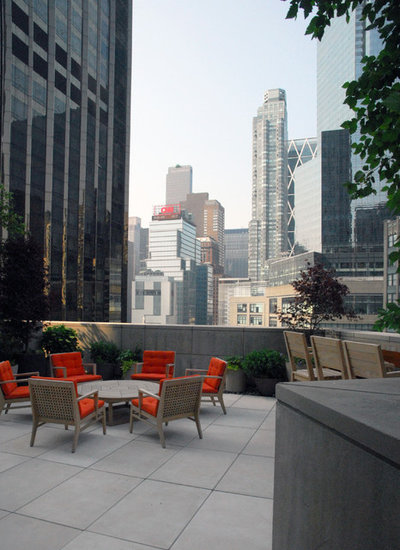
Greenblott Landscape & Interiors
Rethink your furniture and accessories. There is a tendency for homeowners to purchase garden furniture without regard for the big picture. The truth is that carefully chosen and placed furniture pieces can become sculptural elements in their own right, while retaining their functionality.
The terrace here is a case in point. While many would say that nothing is simplistic about the skyline of this metropolitan area, begin to see it as a simplistic arrangement of basic shapes. Notice how the furniture blends into the hardscape; then notice how the chair cushions relate to the sign atop the building in the background, creating a triangle that relates to the whole.
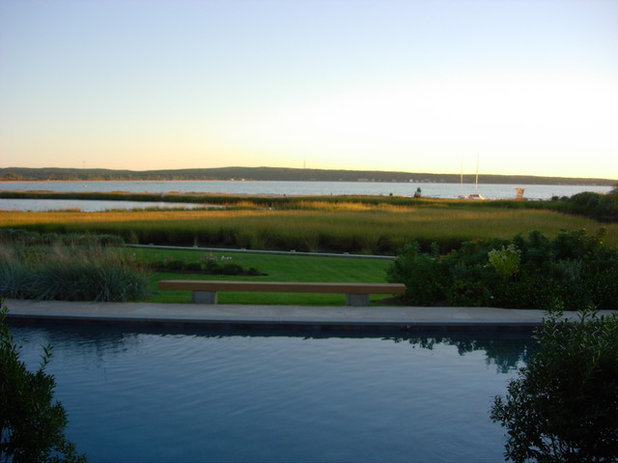
Jack deLashmet and Associates
The long horizontal bench featured in this garden is a brilliant choice. Notice how it widens the eye to absorb the majesty of the space while repeating the lines in the borrowed landscape. A lutyens bench, by contrast, would destroy the serenity of this scene by interrupting the eye. Careful selection of furniture will help clarify the significance of your space.
More: Simplicity vs. Simpleness in Architecture — and Why You Should Care





